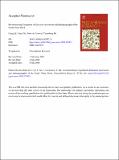Reconstructing Cryogenian to Ediacaran successions and paleogeography of the South China Block
Abstract
Neoproterozoic paleogeography of the South China is dominated by the formation of Rodinia, its break-up, and the subsequent amalgamation of Gondwana. Two negative excursions of the chemical index of alteration (CIA) and the chemical index of weathering (CIW) recorded in the Cryogenian to Ediacaran sedimentary rocks of the Cathaysia Block, South China, indicate two cooling events. In combination with available age constraints, this data suggests correlation with the global Marinoan (ca. 650-635 Ma) and Gaskiers (ca. 579 Ma) glaciations. U-Pb ages of detrital zircons from the Cryogenian to lower Ediacaran strata define two distinctive age peaks at 1056 Ma and 998 Ma, whereas the upper Ediacaran strata show only one age peak at 957 Ma. These data demonstrate Neoproterozoic sedimentary rocks in the Cathaysia Block were derived from a source external to the craton. The predominant late Mesoproterozoic to early Neoproterozoic (1140-870 Ma) detrital zircons were most likely derived from a source dominated by North India and East Antarctica with limited input from Western Australia. Furthermore, εHf(t) values of detrital zircons are similar to the coeval detrital zircons from Rayner-Eastern Ghats. The detrital record of the late Cryogenian and Ediacaran strata in the Cathaysia Block suggests that the South China Block was connected to the northern margin of India during the dispersal of Rodinia and the assembly of East Gondwana. Detrital zircons from Cryogenian strata overlying the Jiangnan Orogen are largely in the range 900-700 Ma with scattered Archean and Paleoproterozoic grains. These ages are consistent with derivation from local sources within South China. The timing of accumulation of these units, after collisional assembly of South China, likely accounts for their more restricted provenance with collision generated relief providing both a local source and restricting input from further south within India and/or the rest of Gondwana.
Citation
Qi , L , Xu , Y , Cawood , P A & Du , Y 2018 , ' Reconstructing Cryogenian to Ediacaran successions and paleogeography of the South China Block ' , Precambrian Research , vol. In press . https://doi.org/10.1016/j.precamres.2018.07.003
Publication
Precambrian Research
Status
Peer reviewed
ISSN
0301-9268Type
Journal article
Description
This work was supported by the National Natural Science Foundation of China (Grant No. 41772106 and 41472086) and by the Australian Research Council (Grant FL160100168).Collections
Items in the St Andrews Research Repository are protected by copyright, with all rights reserved, unless otherwise indicated.

